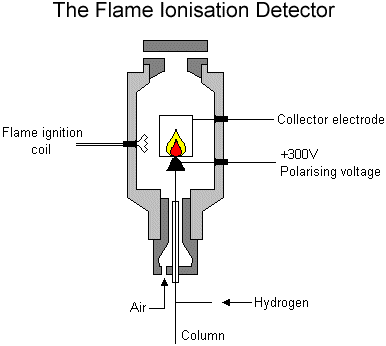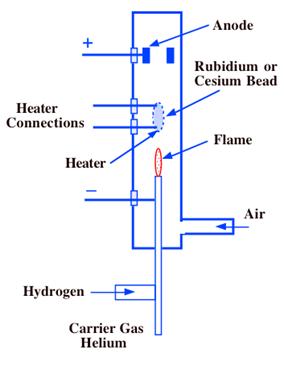Mass flow depend Decorator
- FLAME IONIZATION DETECTOR (FID):
- NITROGEN PHOSPHORUS DETECTOR (NPD):
- FLAME PHOTOMETRIC DETECTOR (FPD):
Concentration type Detector
- ELECTRON CAPTURE DETECTOR (ECD):
- THERMAL CONDUCTIVITY DETECTOR (TCD):
- PHOTOIONIZATION DETECTOR (PID):
- ELECTROLYTIC CONDUCTIVITY DETECTOR (ELCD)
As solutes elute from the column, they interact with the detector. The detector converts this interaction into an electronic signal that is sent to the data system. The magnitude of the signal is plotted versus time (from the time of injection) and a chromatogram is generated.
Some detectors respond to any solute eluting from the column while others respond only to solutes with specific structures, functional groups or atoms
Detectors that exhibit enhanced response to specific types of solutes are called selective detectors.
Most detectors require one or more gases to function properly. There are combustion, reagent, auxiliary and makeup gases. In some cases, one gas may serve multiple purposes. The type of detector gas is dependent on the specific detector and is fairly universal between GC manufacturers. The flow rates for each type of detector varies between GC manufacturers. It is important to follow the recommended flow rates to obtain the optimal sensitivity, selectivity and linear range for a detector
FLAME IONIZATION DETECTOR (FID):
Mechanism: Compounds are burned in a hydrogen-air flame. Carbon containing

compounds produce ions that are attracted to the collector. The number of ions hitting the collector is measured and a signal is generated.
Selectivity: Compounds with C-H bonds. A poor response for some non-hydrogen containing organics (e.g., hexachlorobenzene).
Sensitivity: 0.1-10 ng
Linear range: 105-107
Gases: Combustion – hydrogen and air; Makeup – helium or nitrogen
Temperature: 250-300°C,and 400-450°C for high temperature analyses.
NITROGEN PHOSPHORUS DETECTOR (NPD):
Mechanism: Compounds are burned in a plasma surrounding a rubidium bead supplied with hydrogen and air. Nitrogen and phosphorous containing compounds produce ions that are attracted to the collector. The number of ions hitting the collector is measured and a signal is generated.
Selectivity: Nitrogen and phosphorous containing compounds
Sensitivity: 1-10 pg
Linear range: 104-10-6
Gases: Combustion – hydrogen and air; Makeup – helium
Temperature: 250-300°C
ELECTRON CAPTURE DETECTOR (ECD):
Mechanism: Electrons are supplied from a 63Ni foil lining the detector cell. A current is generated in the cell. Electronegative compounds capture electrons resulting in a reduction in the current. The amount of current loss is indirectly measured and a signal is generated.
Selectivity: Halogens, nitrates and conjugated carbonyls
Sensitivity: 0.1-10 pg (halogenated compounds); 1-100 pg
(nitrates); 0.1-1 ng (carbonyls)
Linear range: 103-104
Gases: Nitrogen or argon/methane
Temperature: 300-400°C
THERMAL CONDUCTIVITY DETECTOR (TCD):
Mechanism: A detector cell contains a heated filament with an applied current. As carrier gas containing solutes passes through the cell, a change in the filament current occurs. The current change is compared against the current in a reference cell. The difference is measured and a signal is generated.
Selectivity: All compounds except for the carrier gas
Sensitivity: 5-20 ng
Linear range: 105-106
Gases: Makeup – same as the carrier gas
Temperature: 150-250°C
FLAME PHOTOMETRIC DETECTOR (FPD):
Mechanism: Compounds are burned in a hydrogen-air flame. Sulfur and phosphorous containing compounds produce light emitting species (sulfur at 394 nm and phosphorous at 526 nm). A monochromatic filter allows only one of the wavelengths to pass. A photomultiplier tube is used to measure the amount of light and a signal is generated. A different filter is required for each detection mode.
Selectivity: Sulfur or phosphorous containing compounds. Only one at a time.
Sensitivity: 10-100 pg (sulfur); 1-10 pg (phosphorous)
Linear range: Non-linear (sulfur); 103-105 (phosphorous)
Gases: Combustion – hydrogen and air; Makeup – nitrogen
Temperature: 250-300°C
PHOTOIONIZATION DETECTOR (PID):
Mechanism: Compounds eluting into a cell are bombarded with high energy photons emitted from a lamp. Compounds with ionization potentials below the photon energy are ionized. The resulting ions are attracted to an electrode, measured, and a signal is generated.
Selectivity: Depends on lamp energy. Usually used for aromatics and olefins (10 eV lamp).
Sensitivity: 25-50 pg (aromatics); 50-200 pg (olefins)
Linear range: 105-106
Gases: Makeup – same as the carrier gas
Temperature: 200°C
ELECTROLYTIC CONDUCTIVITY DETECTOR (ELCD):
Mechanism: Compounds are mixed with a reaction gas and passed through a high temperature reaction tube. Specific reaction products are created which mix with a solvent and pass through an electrolytic conductivity cell. The change in the electrolytic conductivity of the solvent is measured and a signal is generated. Reaction tube temperature and solvent determine which types of compounds are detected.
Selectivity: Halogens, sulfur or nitrogen containing compounds. Only one at a time.
Sensitivity: 5-10 pg (halogens); 10-20 pg (S); 10-20 pg (N)
Linear range: 105-106 (halogens); 104-105 (N); 103.5-104(S)
Gases: Hydrogen (halogens and nitrogen); air (sulfur)
Temperature: 800-1000°C (halogens), 850-925°C (N), 750-825°C (S)